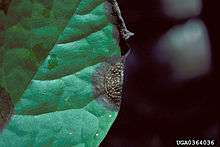Colletotrichum acutatum
Colletotrichum acutatum is a plant pathogen. It is the organism that causes the most destructive fungal disease, anthracnose, of lupin species worldwide.[1] It also causes the disease postbloom fruit drop on many varieties of citrus, especially Valencia and navel oranges in Florida.[2]
| Colletotrichum acutatum | |
|---|---|
 | |
| Scientific classification | |
| Kingdom: | Fungi |
| Division: | Ascomycota |
| Class: | Sordariomycetes |
| Order: | Glomerellales |
| Family: | Glomerellaceae |
| Genus: | Colletotrichum |
| Species: | C. acutatum |
| Binomial name | |
| Colletotrichum acutatum J.H. Simmonds (1968) | |
| Synonyms | |
| |
Host and symptoms
Colletotrichum acutatum has a broad host range, but is most important in strawberries. C. acutatumon strawberries. The pathogen causes black spot of fruit, but can also be seen attacking the plant at its crowns, roots and leaves.[3] After planting, stunting and yellowing as well as wilting may occur. [4] General symptoms of the disease in other plants can also be seen on flowers, petioles, and roots.[5] Stems are also a prominent place to see symptoms. Lesions on the stem can appear dark colored, oval shaped, and possibly have immersed spots located on petioles and runners.[4] Once C.acutatum infects these parts of the plant, it can cause other diseases to unfold such as crown root rot, defoliation, bloom blight and fruit rot.[6] Unfortunately, the most significant loss can be seen once the fruit is attacked.[6] If the fruit is infected it will develop small brown spots (green fruit) or black spots (red fruit) and can expand throughout the fruits’ surface. [4]
Environment
This pathogen has a wide geographical distribution. Strains of the pathogen are present throughout various climates worldwide.[7] Temperature can affect how symptoms appear on the host. Optimal temperature for growth of C. acutatum is 25 degrees Celsius.[6] For instance, in weather with high humidity, orange colored spores appear on the hosts’ lesions.[4] Specifically in strawberries, this disease appears to be more harmful in warm climates.[8] Transference of disease occurs when conidia are spread by water, specifically rain or irrigation water. Another way of contamination is from infected equipment or wind.[4]
Management
Cultural control
Sanitation is critical in controlling the disease. Thoroughly washing plants by removing all the dirt could reduce occurrence.[4] This method has also been demonstrated to reduce pests such has anthracnose.[4] Proper sanitation of equipment could reduce exposure of contracting the pathogen. This would be equipment used in transportation, packing, storage, etc.[6] Crop rotation, as well as the removal of weeds is also helpful in reducing the pathogen in the soil.[4] Removing weeds from the field is a critical step; the pathogen on the dead weeds could still produce spores.[4]
Chemical control
A common method of control for this disease is the use of fungicides. Fungicides are soil fumigants that are used to decrease amount of inoculum in the soil. Chloropicin, a fungicide, has seen good results with regular application.[4] Unfortunately, relying on just one fungicide heavily can increase the diseases’ tolerance.[6] Moreover, the timing of the application is very crucial. With poorly timed applications, there could be an increase of disease severity due to the disturbance of natural biocontrol mechanisms and increased crop susceptibility.[6] Pest control is also crucial in the containment of the disease. After rainfall or irrigation, anthracnose symptoms may occur. Using foliar fungicide can help prevent spread of the disease and minimize anthracnose.[4]
References
- Falconi, Cesar E.; Visser, Richard G. F.; van Heusden, Sjaak (2015). "Influence of plant growth stage on resistance to anthracnose in Andean lupin (Lupinus mutabilis)". Crop and Pasture Science. 66 (7): 729. doi:10.1071/CP14104. ISSN 1836-0947.
- N.A. Peres and M.M. Dewdney, (2016). 2016 Florida Citrus Pest Management Guide: Ch. 22 "Postbloom Fruit Drop" Publication #PP-45, University of Florida IFAS Extension.
- Damm, U.; Cannon, P.F.; Woudenberg, J.H.C.; Crous, P.W. (2012-09-01). "The Colletotrichum acutatum species complex". Studies in Mycology. 73 (1): 37–113. doi:10.3114/sim0010. ISSN 0166-0616. PMC 3458416. PMID 23136458.
- "Anthracnose / Strawberry / Agriculture: Pest Management Guidelines / UC Statewide IPM Program (UC IPM)". www2.ipm.ucanr.edu. Retrieved 2018-12-11.
- Peres, N. A.; Timmer, L. W.; Adaskaveg, J. E.; Correll, J. C. (2005). "APS Journals". Plant Disease. 89 (8): 784–796. doi:10.1094/pd-89-0784. PMID 30786507.
- "The biology of Colletotrichum acutatum" (PDF). digital.csic.es. Retrieved 2018-12-11.
- Baroncelli, Riccardo; Talhinhas, Pedro; Pensec, Flora; Sukno, Serenella A.; Le Floch, Gaetan; Thon, Michael R. (2017-10-11). "The Colletotrichum acutatum Species Complex as a Model System to Study Evolution and Host Specialization in Plant Pathogens". Frontiers in Microbiology. 8: 2001. doi:10.3389/fmicb.2017.02001. ISSN 1664-302X. PMC 5641571. PMID 29075253.
- "Colletotrichum acutatum" (PDF). www.cabi.org. Retrieved 2018-12-11.
External links